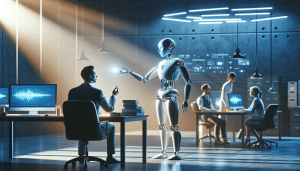Can AI Revolutionize Everyday Life for You
Aiden Foster September 21, 2025
Artificial intelligence influences everything from search engines to smart homes. This guide explores practical ways AI technology integrates with daily routines, reveals how it impacts decision-making, and helps readers understand both its immediate benefits and future potential. Find out why so many are looking for ways AI is changing life as we know it.
The Rise of Artificial Intelligence in Daily Tasks
Artificial intelligence no longer exists only in advanced laboratories or tech startups; it’s weaving itself into the fabric of daily activities across the world. Whether it’s the recommendation engine suggesting what movie to watch next or the smart assistant setting reminders, AI is part of life for countless users. These technologies process large sets of data rapidly, personalize experiences, and adapt to individual preferences with surprising accuracy. This integration means that AI applications touch everything from smart home devices to complex algorithms powering social media feeds and search engines. For many, it’s no longer a question of if AI will impact their day but how deeply it already does.
One striking example: voice assistants have transformed how people interact with their devices, which demonstrates the subtle yet powerful presence of AI. These assistants interpret spoken language, manage smart home systems, and even order groceries with just a few words. By learning from user behavior, voice AI becomes more efficient over time, reflecting advances in machine learning. This shift reduces everyday friction, saving time and mental effort when juggling multiple tasks or managing busy schedules.
The future promises even deeper AI integration. As machine learning algorithms become more sophisticated, predictive text, contextual suggestions, and automation tools will evolve—helping people schedule meetings, track health, and even optimize budgets. AI-driven personalization creates opportunities for enhanced productivity and seamless living, opening new questions and possibilities about which aspects of modern life algorithms may influence next.
Machine Learning Behind Personalization
Machine learning is the backbone of many AI-powered services. When you stream videos or shop online, recommendation systems use a blend of past behavior and real-time data to tailor experiences uniquely suited to individual needs. This has transformed e-commerce, online entertainment, and even news delivery. Algorithms sift through immense datasets, identifying patterns that would go unnoticed by humans. The result? Content and products that seem to know interests without requiring explicit input—enhancing efficiency while subtly shaping personal preferences. These machine learning capabilities optimize not just convenience but also engagement, making platforms more intuitive to use.
In education, adaptive learning platforms rely on AI logic to adjust difficulty levels and recommend resources suited to each learner’s pace. Whether students need extra practice or additional challenges, the system adapts, providing ongoing tailored support. This is possible because algorithms run in the background, analyzing progress, and using predictive analytics to anticipate what content offers the most value at any given moment. This shift toward personalization improves outcomes and helps bridge gaps that traditional models sometimes leave behind.
Healthcare is another sphere benefiting from AI-driven recommendations and personalization. Wearable devices collect data round the clock, alerting users to sleep patterns, activity levels, or potential anomalies in vital signs. AI processes this stream of information, often predicting issues before symptoms appear. With these advancements, technology not only offers data—it translates it into meaningful feedback, making everyday decisions about well-being more informed and accessible.
Smart Home Technology and Connected Devices
Smart home devices powered by AI have revolutionized how people interact with their living spaces. From thermostats learning temperature preferences to security systems that detect unusual activity, these solutions add a new layer of comfort and peace of mind. AI enables lights, appliances, and entertainment systems to communicate and adapt, creating an environment tailored to routines. Many find AI in smart homes helpful for energy efficiency, as devices adjust settings automatically to minimize waste. This not only benefits the environment but can also lower utility bills—making smart technology a practical addition to everyday life for many households.
Integration between devices is one of the key advantages of AI-driven smart home ecosystems. For instance, sensors can detect movement, automatically unlocking doors or adjusting lighting levels according to the time of day. The process is seamless, requiring little user intervention once preferences are set. Home assistants respond to voice commands, manage multiple devices, and learn usage patterns over time. This interconnectivity reduces manual tasks and helps occupants make the most of modern convenience, whether they are tech-savvy or just beginning to explore these new possibilities.
Security remains a top concern with connected devices, but advances in AI offer stronger safeguards than ever. Facial recognition, anomaly detection, and real-time monitoring are built into many security systems, alerting users of potential threats instantly. These automated systems learn over time, improving accuracy, and reducing false alarms. As smart home adoption grows, AI will continue to expand capabilities while balancing privacy and stability—an ongoing conversation in the tech world that shapes innovation moving forward.
AI and Data Privacy Considerations
The widespread adoption of artificial intelligence introduces important questions about privacy and data security. AI systems are reliant on large datasets, often containing personal information that is sensitive in nature. Consumers are increasingly aware of how their data is used, stored, and shared across various platforms. Regulatory bodies and organizations have responded by developing guidelines and frameworks to address risks while fostering innovation. Transparency and ethical AI design are becoming standard, offering users more visibility and control over personal information handled by automated systems.
Data privacy concerns have inspired new legislation across several countries, designed to protect users from misuse or unauthorized access to personal data. These rules encourage companies to develop AI systems with a ‘privacy by design’ approach, limiting the retention of unnecessary data and emphasizing anonymization techniques. While compliance is an ongoing challenge, many see these standards as essential for gaining consumer trust and ensuring safe adoption of new technology. Understanding the intricacies of privacy regulations helps inform choices about which platforms or devices are most aligned with users’ comfort levels.
The AI community continues to explore responsible approaches to data handling, including explainable AI, encrypted data storage, and consent management tools. Educating users about these safeguards is a vital part of broader AI literacy, helping individuals understand their rights and options. As AI technology becomes more embedded in daily routines, ongoing advancements in privacy and ethics will be key to balancing the promise of smart automation with the protection of individual autonomy.
Everyday Applications: From Search to Shopping
Most encounters with artificial intelligence today happen through common applications. When using a search engine, AI ranks results, provides answers, and even interprets search intent based on past queries and context. Online shopping is another area where AI has tremendous impact: product recommendations, fraud detection, and personalized promotions rely on advanced analytics to curate experiences tailored to individual behaviors. These innovations streamline decision-making for users while helping businesses meet needs more effectively.
In communication, AI augments email sorting, spam detection, and autocorrect, ensuring that messages are relevant and concise. Within financial services, automated chatbots assist with account management or answer frequently asked questions at any time. This round-the-clock availability showcases the “always-on” nature of AI, providing support and guidance without waiting in line or on hold. The growing presence of AI across industries hints at its potential to change expectations about speed and accuracy in modern customer service.
For many, these AI-powered applications are so seamlessly integrated that their underlying complexity goes unnoticed. Yet, the broad reach of machine learning algorithms ensures that each search, message, or transaction benefits from ongoing advances in data processing. Everyday experiences are improved, not just for tech enthusiasts, but for anyone looking to save time and find greater efficiency in routine actions—a testament to the far-reaching effects of artificial intelligence in society.
The Future of AI: Opportunities and Challenges
Looking ahead, artificial intelligence is expected to play a central role in addressing global challenges, from climate modeling to personalized health solutions. The technology’s ability to process vast quantities of complex data makes it invaluable for discoveries that were previously out of reach. However, alongside optimism, there’s growing discussion about potential risks: bias in algorithms, workforce shifts, and the question of transparency in automated decision-making. Society is now tasked with guiding the responsible growth of AI while maximizing its benefits for everyone.
Education and ongoing skill development are increasingly important in a world shaped by AI. By fostering digital literacy, individuals and communities are better equipped to adapt, ask critical questions, and participate in shaping the future of this transformative tool. Research institutions, non-profits, and industry leaders collaborate on guidelines and open standards, ensuring that progress moves hand-in-hand with accountability. This cooperative spirit fosters new opportunities, empowering users to explore AI’s positive impact in their personal and professional lives.
The continuous evolution of artificial intelligence will likely yield both expected and surprising outcomes. As technology advances, open dialogue and inclusivity will be essential for aligning AI’s trajectory with shared values. By embracing change and remaining curious, society can unlock innovation without losing sight of the human factors that matter most. The potential for positive transformation is enormous—and the journey with AI has only just begun.
References
1. European Commission. (n.d.). Artificial Intelligence – Technology, Applications, and Policy Considerations. Retrieved from https://digital-strategy.ec.europa.eu/en/policies/artificial-intelligence
2. US Department of Energy. (n.d.). The Role of Artificial Intelligence in Everyday Life. Retrieved from https://www.energy.gov/articles/artificial-intelligence-powering-future
3. Harvard University. (n.d.). Machine Learning and the Future of Personalization. Retrieved from https://sitn.hms.harvard.edu/flash/2017/personalized-world-recommender-systems-promises-and-pitfalls/
4. National Institute of Standards and Technology. (2023). AI Risk Management Framework. Retrieved from https://www.nist.gov/itl/ai-risk-management-framework
5. MIT Open Learning. (n.d.). Machine Learning Applications in the Real World. Retrieved from https://openlearning.mit.edu/blog/6-examples-machine-learning-applications-real-world
6. Pew Research Center. (2022). AI and the Future of Humans. Retrieved from https://www.pewresearch.org/internet/2022/03/24/ai-and-the-future-of-humans/








